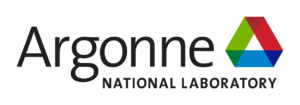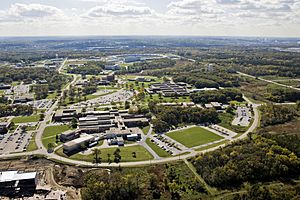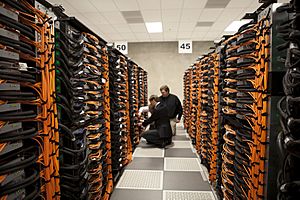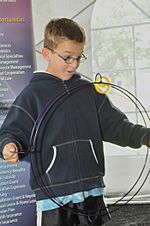Argonne National Laboratory facts for kids
 |
|

Aerial view of Argonne National Laboratory
|
|
| Established | February 8, 1946 |
|---|---|
| Research type | Research |
| Budget | $1.1 billion (2022) |
|
Field of research
|
Physical science Life science Environmental science Energy science Photon science Data science Computational science |
| Director | Paul Kearns |
| Staff | 3400 |
| Address | 9700 S. Cass Avenue |
| Location | Lemont, Downers Grove Township, DuPage County, Illinois, USA |
| Campus | 1,700 acres (6.9 km2) |
| Affiliations | United States Department of Energy University of Chicago Jacobs Engineering |
|
Operating agency
|
UChicago Argonne LLC |
| Enrico Fermi Maria Goeppert Mayer Alexei Alexeyevich Abrikosov |
|
| Website | www.anl.gov |
Argonne National Laboratory is a big science center in Lemont, Illinois, USA. It's funded by the US government. It started in 1946 and is managed by the University of Chicago. Argonne is the largest national science lab in the Midwest.
Argonne began during World War II as part of the Manhattan Project. This project aimed to build the first nuclear reactors. After the war, Argonne became the first national laboratory in the United States. Today, over 1,000 scientists work there. They research things like energy storage, renewable energy, physics, chemistry, and materials science. They also work on environmental sustainability, supercomputing, and national security.
Argonne used to have a smaller lab in Idaho called Argonne-West. In 2005, it joined with another lab to form the Idaho National Laboratory. Argonne is now part of a growing area in Illinois known for technology and research.
Contents
What Argonne Does
Argonne focuses on five main areas of science. These include making new scientific discoveries in physical and life sciences. They also do research on energy and climate change. Another goal is to improve global security to keep society safe. Argonne also runs huge research facilities. These facilities help thousands of scientists and engineers from all over the world. Finally, Argonne helps train new scientists and engineers for the future.
Argonne's History
How Argonne Started
Argonne began in 1942 as the Metallurgical Laboratory at the University of Chicago. This lab was part of the Manhattan Project. There, scientists built Chicago Pile-1, the world's first nuclear reactor. It was built under the stands of a sports stadium! In 1943, this reactor was moved to a forest preserve outside Chicago. This new site became known as "Site A."
On July 1, 1946, Site A officially became Argonne National Laboratory. Its goal was to do "cooperative research in nucleonics." The US government asked Argonne to develop nuclear reactors for peaceful energy. In the late 1940s and early 1950s, the lab moved to a bigger location. It also set up a remote site in Idaho, called "Argonne-West," for more nuclear research.
Early Discoveries
In its early years, Argonne focused on creating ways to make electricity from nuclear reactions. The lab designed and built Chicago Pile 3 (1944). This was the world's first reactor to use heavy water. In 1951, the Experimental Breeder Reactor I in Idaho made history. It lit up four light bulbs with the world's first nuclear-generated electricity. The BWR design, now very common, also came from Argonne's experiments.
The knowledge from Argonne's early work helped design most commercial nuclear power plants worldwide. It also helps with new designs for future power stations.
Argonne also helped design the reactor for the first nuclear-powered submarine. This was the U.S.S. Nautilus. It traveled over 513,550 nautical miles using nuclear power. This work helped create the United States' nuclear navy.
Not all nuclear research was about reactors. In 1957, an Argonne physicist named William Nelson Beck put his arm into a scanner. He was designing it for reactor fuel. This led to one of the first ultrasound images of the human body. Machines designed to handle radioactive materials also helped create robots. These robots are now used to clean up dangerous areas.
Argonne also did basic research in physics and chemistry. In 1955, Argonne chemists helped find two new elements. These were einsteinium and fermium, numbers 99 and 100 on the periodic table.
1960 to 1995
In 1962, Argonne chemists made the first compound of the noble gas xenon. This opened up new research into how chemicals bond. In 1963, they discovered the hydrated electron.
Argonne was chosen for the 12.5 GeV Zero Gradient Synchrotron. This was a particle accelerator that opened in 1963. Scientists used a bubble chamber to watch tiny subatomic particles. They even saw the neutrino for the first time in a hydrogen bubble chamber.
In 1964, the "Janus" reactor opened. It studied how neutron radiation affects living things. This research helped create safety rules for workers in power plants and hospitals. Argonne scientists also created a way to study the Moon's surface using alpha radiation. This technology went to the Moon on the Surveyor 5 in 1967. It later helped analyze Moon samples from the Apollo 11 mission.
In 1978, the Argonne Tandem Linac Accelerator System (ATLAS) opened. It was the world's first superconducting accelerator for heavy particles.
During this time, nuclear engineering experiments continued. These included the Experimental Boiling Water Reactor and Experimental Breeder Reactor II (EBR-II). EBR-II was cooled by sodium and could recycle its own fuel. In 1982, it was used to test the Integral fast reactor concept. This design could reprocess its own fuel and reduce atomic waste. It also passed safety tests that showed it could handle the same problems that caused the Chernobyl and Three Mile Island accidents. However, in 1994, the US Congress stopped funding most of Argonne's nuclear programs.
Argonne then started to focus on other areas. It used its experience in physics, chemistry, and metallurgy. In 1987, the lab showed a new way to speed up particles. This was called plasma wakefield acceleration. It can accelerate particles much faster than older methods. Argonne also started a strong battery research program.
After a big effort by director Alan Schriesheim, Argonne was chosen for the Advanced Photon Source. This huge X-ray facility was finished in 1995. It made the brightest X-rays in the world at that time.
Since 1995
Argonne kept growing as a center for energy research. It also became a place for scientific facilities that are too big for universities to have.
In the early 2000s, the Argonne Leadership Computing Facility started. It has hosted many supercomputers. Some of these were among the top 10 most powerful in the world. The lab also built the Center for Nanoscale Materials. This center studies materials at the atomic level. Argonne also greatly expanded its battery research and quantum technology programs.
In 2019, the Chicago Tribune reported that Argonne was building the world's most powerful supercomputer. It will cost $500 million and be incredibly fast. It will be used to study stars and improve the power grid.
Key Research Areas
- Powerful X-ray Science: Argonne has the Advanced Photon Source (APS). This is one of the world's largest high-energy X-ray sources. Scientists use the APS to study materials and processes. For example, they can see how fuel injectors spray gasoline in engines.
- Supercomputing Leadership: Argonne has some of the fastest computers for open science. They also create software for these huge machines. Argonne works to make supercomputing even better, from petascale to exascale. They develop new computer programs to solve big science problems. For instance, in 2009, they started a project to use cloud computing for science.
- Materials for Energy: Argonne scientists try to understand and control how atoms and molecules are arranged. This helps them create materials with special properties. They helped develop an ice slurry to cool heart attack victims. They also found a superinsulator material. This material stops electric current better than any other.
- Storing Electrical Energy: Argonne develops batteries for electric transportation technology like electric cars. They also work on batteries to store energy from wind or solar for the power grid. The lab has been researching advanced battery materials for over 50 years. Recently, they have focused on lithium-ion batteries. Argonne also tests batteries from companies and the government. They check how well batteries work over time and in different temperatures.
- New Energy and Efficiency: Argonne creates chemical and biological fuels for engines. They also improve how engines burn fuel. The lab has suggested ways to save fuel. For example, they found that trucks should use small heaters instead of idling their engines. Their solar energy research focuses on making solar-fuel and solar-electric systems cheaper and more effective. Argonne scientists also study how to make a smart grid work better.
- Nuclear Energy: Argonne develops advanced reactor and fuel cycle technologies. These help create safe and sustainable nuclear power. Argonne scientists create computer models to simulate future nuclear reactors. Another project studies how to reprocess spent nuclear fuel. This can reduce nuclear waste by up to 90%.
- Biology and Environment: Argonne scientists study how the environment and human activities affect each other. This helps us understand climate change. Their programs include using trees to remove pollutants from groundwater. They also develop biochips to find cancers early. Other projects include using nanoparticles to target cancer cells.
- National Security: Argonne develops technologies to prevent and lessen big disasters. This includes sensors that can find chemical, biological, nuclear, and explosive materials. They also make portable Terahertz radiation ("T-ray") machines. These can find dangerous materials more easily than X-rays at airports. They also track and model how chemicals might spread in places like subways.
Special Facilities for Scientists
Argonne builds and takes care of huge scientific facilities. These are too expensive for one company or university to build. Scientists from Argonne, companies, universities, other national labs, and international groups use these facilities.
- Advanced Photon Source (APS): This facility makes the brightest X-ray beams in the Western Hemisphere. It's like a super powerful X-ray machine for research.
- Center for Nanoscale Materials (CNM): This facility is next to the APS. It has tools to study nanotechnology and nanomaterials. It's one of five such centers in the US.
- Argonne Tandem Linac Accelerator System (ATLAS): ATLAS is the world's first superconducting linear accelerator. It speeds up heavy particles to study the properties of the nucleus. The nucleus is the core of matter and what powers stars.
- Argonne Leadership Computing Facility (ALCF): This facility provides supercomputers for scientists. It helps them make big discoveries in science and engineering.
Research Centers
- The Advanced Materials for Energy-Water Systems (AMEWS) Center studies challenges where water meets materials. It's led by Argonne and includes the University of Chicago and Northwestern University.
- Electron Microscopy Center (EMC): This center uses powerful electron microscopes. It studies how materials change and how they are affected by radiation. It has a unique microscope that combines with an accelerator.
- Biology Center (SBC): This center is located near the Advanced Photon Source. It specializes in macromolecular crystallography. Scientists use it to map the crystal structures of proteins. They have studied proteins from things like anthrax and salmonella.
- The Network Enabled Optimization System (NEOS) Server is an online tool for solving complex math problems. It helps with problems in business, science, and engineering.
- The Joint Center for Energy Storage Research (JCESR) is a group of labs, universities, and companies. It's based at Argonne. Its goal is to design new batteries for the future.
- The Midwest Integrated Center for Computational Materials (MICCoM) is also at Argonne. It creates computer software and data to predict how materials will behave. This helps with energy transformation processes.
- The ReCell Center is a national group working on battery recycling. It's led by Argonne. The center aims to create a sustainable battery recycling industry. It develops ways to recycle lithium-ion and future batteries.
Learning and Community Programs
Argonne offers guided tours for people aged 16 and older. For kids under 16, Argonne has hands-on learning activities. These are great for school field trips. The lab also hosts science and engineering events for local schools.
Every year, Argonne scientists and engineers help train almost 1,000 college students. They also work with post-doctoral researchers as part of their studies.
Directors of Argonne
Over the years, 13 people have been the director of Argonne:
- 1946–1956 Walter Zinn
- 1957–1961 Norman Hilberry
- 1961–1967 Albert V. Crewe
- 1967–1973 Robert B. Duffield
- 1973–1979 Robert G. Sachs
- 1979–1984 Walter E. Massey
- 1984–1996 Alan Schriesheim
- 1996–1998 Dean E. Eastman
- 1999–2000 Yoon Il Chang
- 2000–2005 Hermann A. Grunder
- 2005–2008 Robert Rosner
- 2009–2014 Eric Isaacs
- 2014–2016 Peter Littlewood
- 2017–present Paul Kearns
Argonne in Movies
Parts of the 1996 movie Chain Reaction were filmed at Argonne. They used the Zero Gradient Synchrotron room and an old laboratory.
Famous People at Argonne
- Alexei Alexeyevich Abrikosov
- Khalil Amine
- Paul Benioff
- Charles H. Bennett
- Sandra Biedron
- Margaret K. Butler
- David Callaway
- Yanglai Cho
- George Crabtree
- Seth Darling
- Harold B. Evans
- Paul Fenter
- Enrico Fermi
- Stuart Freedman
- Ian Foster
- Wallace Givens
- Raymond Goertz
- Maury C. Goodman
- Morton Hamermesh
- Cynthia Hall
- Katrin Heitmann
- Caroline Herzenberg
- Paul Kearns
- Harold Lichtenberger
- Maria Goeppert Mayer
- William McCune
- Joël Mesot
- Carlo Montemagno
- José Enrique Moyal
- Gilbert Jerome Perlow
- Lloyd_Quarterman
- Aneesur Rahman
- John P. Schiffer
- Luise Meyer-Schützmeister
- Rolf Siemssen
- Dorothy Martin Simon
- Lynda Soderholm
- Marius Stan
- Rick Stevens
- Valerie Taylor
- Marion C. Thurnauer
- Carlos E.M. Wagner
- Kameshwar C. Wali
- Larry Wos
- Cosmas Zachos
- Daniel Zajfman
- Nestor J. Zaluzec
See also
 In Spanish: Laboratorio Nacional Argonne para niños
In Spanish: Laboratorio Nacional Argonne para niños





